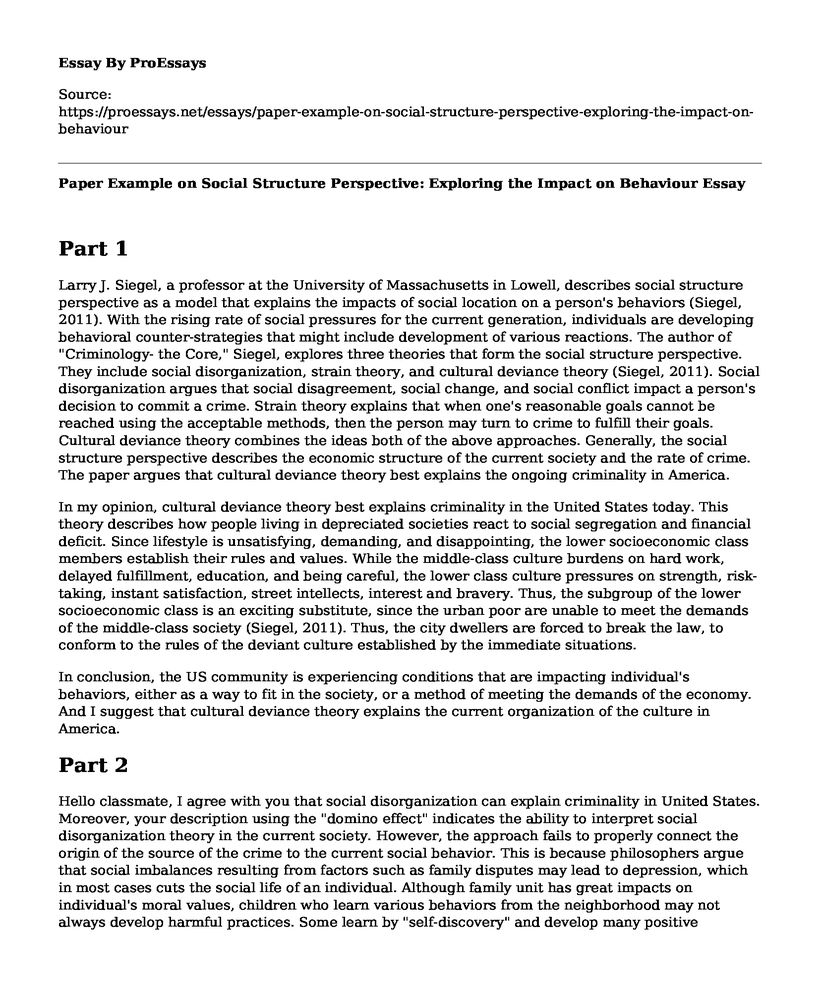Part 1
Larry J. Siegel, a professor at the University of Massachusetts in Lowell, describes social structure perspective as a model that explains the impacts of social location on a person's behaviors (Siegel, 2011). With the rising rate of social pressures for the current generation, individuals are developing behavioral counter-strategies that might include development of various reactions. The author of "Criminology- the Core," Siegel, explores three theories that form the social structure perspective. They include social disorganization, strain theory, and cultural deviance theory (Siegel, 2011). Social disorganization argues that social disagreement, social change, and social conflict impact a person's decision to commit a crime. Strain theory explains that when one's reasonable goals cannot be reached using the acceptable methods, then the person may turn to crime to fulfill their goals. Cultural deviance theory combines the ideas both of the above approaches. Generally, the social structure perspective describes the economic structure of the current society and the rate of crime. The paper argues that cultural deviance theory best explains the ongoing criminality in America.
In my opinion, cultural deviance theory best explains criminality in the United States today. This theory describes how people living in depreciated societies react to social segregation and financial deficit. Since lifestyle is unsatisfying, demanding, and disappointing, the lower socioeconomic class members establish their rules and values. While the middle-class culture burdens on hard work, delayed fulfillment, education, and being careful, the lower class culture pressures on strength, risk-taking, instant satisfaction, street intellects, interest and bravery. Thus, the subgroup of the lower socioeconomic class is an exciting substitute, since the urban poor are unable to meet the demands of the middle-class society (Siegel, 2011). Thus, the city dwellers are forced to break the law, to conform to the rules of the deviant culture established by the immediate situations.
In conclusion, the US community is experiencing conditions that are impacting individual's behaviors, either as a way to fit in the society, or a method of meeting the demands of the economy. And I suggest that cultural deviance theory explains the current organization of the culture in America.
Part 2
Hello classmate, I agree with you that social disorganization can explain criminality in United States. Moreover, your description using the "domino effect" indicates the ability to interpret social disorganization theory in the current society. However, the approach fails to properly connect the origin of the source of the crime to the current social behavior. This is because philosophers argue that social imbalances resulting from factors such as family disputes may lead to depression, which in most cases cuts the social life of an individual. Although family unit has great impacts on individual's moral values, children who learn various behaviors from the neighborhood may not always develop harmful practices. Some learn by "self-discovery" and develop many positive qualities. Since it is not still true that a person with emotional stress will commit crime, it is also clear that the theory leaves out some aspects that are explained by the culture deviant theory.
The culture deviation uses the ideology of social disorganization where social imbalances may lead to the development of various criminal activities and strain theory, where one uses unreasonable methods to fulfill just goals. Social confusion causes pressure on individuals, while strain makes them react to the imbalances by engaging in criminal activities to satisfy their life stresses.
In summation, the essay by the classmate has compelling points, but with additional information that social imbalances caused by strain may result in criminal activities, as typically seen in the contemporary US. Therefore, culture deviation theory best explains criminality in the United States and every other state since life has become more demanding, hence more vigorous actions needed to meet the current life strains.
Reference
Siegel, L. J. (2011). Criminology: the core. Boston, MASS: Wadsworth, Cengage Learning. Retrieved from: https://svetn.org/uploads/docs/G._Hamm_Criminology_Course_Syllabus_for_SVETN_site.doc
Cite this page
Paper Example on Social Structure Perspective: Exploring the Impact on Behaviour. (2023, Feb 20). Retrieved from https://proessays.net/essays/paper-example-on-social-structure-perspective-exploring-the-impact-on-behaviour
If you are the original author of this essay and no longer wish to have it published on the ProEssays website, please click below to request its removal:
- Whether Blacks Have Higher Rates of Hypertension as Compared to White Races?
- Women Roles in the United States Essay Example
- Essay Example on Gun Control: A Divisive Political Issue in the US
- Essay on 1960s Civil Rights Movement Inspires Lee's 'To Kill a Mockingbird'.
- Criminal Justice Research: Ethical Considerations for Practitioners - Essay Sample
- Suicide in Australia: Statistics and Causes - Paper Example
- Free Essay on Interpersonal Communication in Age of Social Media: Impacts on Users







